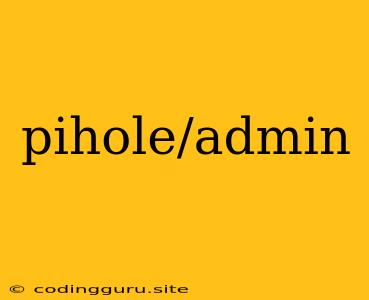Pi-hole: The Ultimate Guide to Your Ad-Blocking Admin Panel
Are you tired of annoying ads popping up everywhere you go? Do you want to reclaim your online experience and browse the web without distractions? Then Pi-hole is the solution for you.
Pi-hole is a powerful network-level ad blocker that runs on your local network. It works by blocking ads and trackers at the DNS level, preventing them from ever reaching your devices. This means you can enjoy a faster, cleaner, and more private browsing experience.
But how do you manage this powerful tool? That's where the Pi-hole admin panel comes in. This web-based interface gives you complete control over your Pi-hole setup, allowing you to customize your ad blocking experience.
Navigating the Pi-hole Admin Panel
The Pi-hole admin panel is surprisingly easy to navigate. Here's a breakdown of the key features and how to use them:
1. Dashboard:
- Overview: The dashboard provides a quick overview of your Pi-hole's performance. It shows the number of ads blocked, DNS queries, and other important metrics.
- Graphs: Detailed charts allow you to visualize your ad blocking activity over time. This helps you understand the impact of Pi-hole on your network.
- Alerts: Pi-hole can alert you if there are any problems, such as connectivity issues or DNS errors. This ensures your ad blocking is running smoothly.
2. Queries:
- Log: The query log provides a detailed breakdown of every DNS request that has been processed by Pi-hole. You can filter the log by date, domain, and other criteria.
- Blacklist: The blacklist allows you to manually block specific domains from being accessed on your network. This can be helpful for blocking sites that you don't want to visit or that are known to contain malware.
- Whitelist: The whitelist allows you to specify domains that should always be allowed through, even if they are normally blocked. This is useful for websites that you rely on for essential services.
3. Settings:
- General: The general settings allow you to configure basic Pi-hole options, such as the DNS server address, the interface used for the web panel, and the password for accessing the panel.
- Groups: Groups allow you to organize your blocked domains into different categories, such as "Advertising," "Tracking," or "Malware." This can be helpful for managing a large number of blocked domains.
- Gravity: The Gravity settings allow you to update the Pi-hole blacklist from external sources, such as the "Gravity" list maintained by the Pi-hole community. This ensures your blacklist is always up-to-date with the latest known ad domains.
4. Tools:
- Update: The update tool allows you to check for and install the latest Pi-hole updates. This is important for keeping your Pi-hole secure and up-to-date with the latest ad-blocking techniques.
- CLI: The command line interface (CLI) allows you to interact with Pi-hole using commands. This provides more flexibility and control over the system.
- Debug: The debug tool helps you troubleshoot any issues you might be experiencing with Pi-hole. It provides detailed logs and information that can be used to identify the source of the problem.
Tips for Using the Pi-hole Admin Panel
- Understand Your Network: Before you start customizing your Pi-hole, make sure you understand how your network is configured. This will help you choose the appropriate settings for your setup.
- Start Simple: Don't be afraid to start with the basic settings and gradually add more features as you become more comfortable with Pi-hole.
- Customize Your Blacklist: The default blacklist provided by Pi-hole is a great starting point, but you can also customize it to block domains that are specific to your needs.
- Keep It Updated: Regularly check for updates and install them to ensure your Pi-hole is always running at its best.
- Learn the Command Line: While the web panel is user-friendly, the CLI provides even more power and flexibility. Learn the basic commands to get the most out of your Pi-hole.
Troubleshooting Pi-hole
If you encounter any problems with your Pi-hole setup, the admin panel can be a valuable tool for troubleshooting. Here are some tips:
- Check the Dashboard: The dashboard can provide valuable insights into the health of your Pi-hole. Look for any error messages or performance issues.
- Review the Query Log: The query log can help you identify specific domains that are causing problems.
- Use the Debug Tool: The debug tool provides detailed information that can be used to diagnose issues.
- Consult the Documentation: The official Pi-hole documentation is a great resource for troubleshooting tips and solutions.
- Join the Community: The Pi-hole community is very active and helpful. You can find answers to your questions and get support from other Pi-hole users.
Conclusion
The Pi-hole admin panel is an essential part of the Pi-hole experience. It provides you with complete control over your ad blocking setup, allowing you to customize your experience and troubleshoot any issues. With its intuitive interface and powerful features, the Pi-hole admin panel empowers you to reclaim your online experience and enjoy a cleaner, faster, and more private browsing experience.
